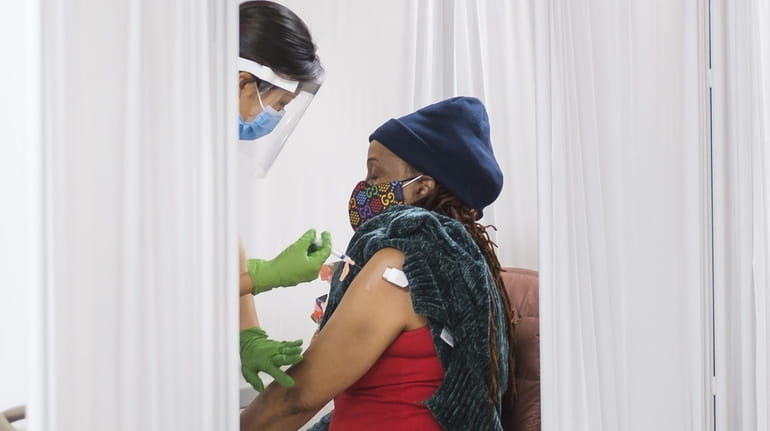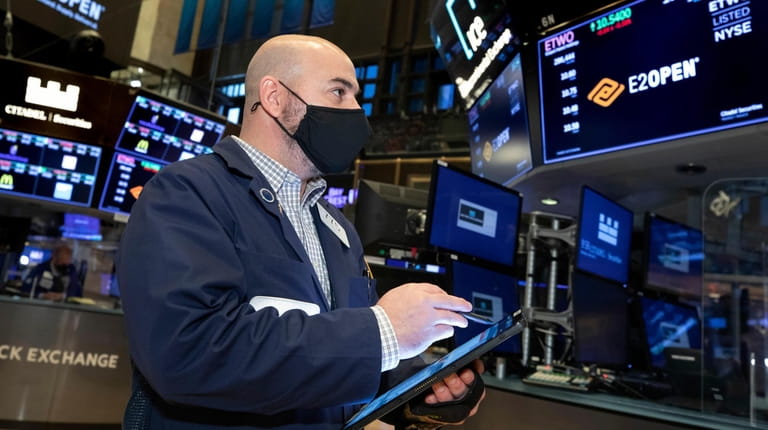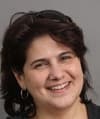Cuomo: New York expecting a 5% increase in weekly vaccine supply, but needs more

A woman receives the vaccine Monday at a pop-up site at the Abyssinian Baptist Church in Harlem. Credit: Justin Lane/EPA-EFE/Shutterstock
This story was reported by Matthew Chayes, Lisa L. Colangelo, Joan Gralla, Bart Jones and Yancey Roy. It was written by Colangelo and Jones.
New York is slated to receive an additional 5% in COVID-19 vaccine for at least three weeks as the federal government works with manufacturers to ramp up production and deliveries to the states, Gov. Andrew M. Cuomo said Tuesday.
He said the latest increase, on top of recent boosts of 16% and 5%, is "significant" and "helpful" but "not proportionate to the need" of New York.
"We now have 10 million New Yorkers waiting on 300,000 doses" delivered per week, said Cuomo, who updated reporters after a phone conference with the White House and the National Governor’s Association.
Cuomo and state officials did not specify the exact amount of doses expected, though a state official said the new increase should start with next week's allocation.
In addition, Cuomo said the state soon will be allowed to reallocate unused vaccine doses that had been set aside for nursing homes and are no longer needed for that effort.
The White House also announced Tuesday that vaccine doses will be sent directly to federally qualified health centers across the U.S. starting the week of Feb. 15. That initiative will start with one FQHC in each state and expand to 250.
"A big question on the call with the White House coordinator by the governors is supply, supply, supply," Cuomo said.
The head of one FQHC organization on Long Island called the announcement "great" news.
"We’re definitely struggling to get" vaccines, said David Nemiroff, president and CEO of Westbury-based Long Island FQHC Inc. "If we can get them directly from the federal government, that would be amazing."
Nemiroff, whose group runs FQHCs in communities including Hempstead, Roosevelt, Freeport, Westbury, Elmont, Oceanside and New Cassel, said he has not received a single dose for his patients.
By Feb. 15, with the inclusion of people with comorbidities or higher-risk health issues, his group will have 28,000 people eligible for shots. Most of the group’s patients are below the federal poverty line and are from minority communities, he said.
President Joe Biden's administration has gradually stepped up distribution over its first weeks in office, but is limited by how much the manufacturers of the Pfizer-BioNTech and Moderna vaccines can produce.
Cuomo said his hopes are pinned on authorization of a third vaccine option by Johnson & Johnson, a matter to be considered over the next several weeks.
"Johnson and Johnson would be a major and significant increase in production," he said.
Being able to reallocate unused and unneeded doses from nursing homes could free up tens of thousands of shots.
"That program has been slower than anticipated and we believe it was over-allocated," Cuomo said.
About 2.5 million doses of the COVID-19 vaccine have been administered in New York, meaning that about 10% of all state residents have received the first of two doses of either the Moderna or Pfizer-BioNTech shots.
"That is a big deal, and this vaccine is the weapon that will win the war," Cuomo said.
The governor said 11 new community-based pop-up vaccination sites will open this week around the state, including two on Long Island.
The sites, located at community centers, public housing complexes and cultural centers in New York City, Long Island and the Hudson Valley, are expected to vaccinate more than 3,100 people during the week.
The sites include the Gerald Ryan Outreach Center, 1434 Straight Path, in Wyandanch, on Friday from 9 a.m. to 2 p.m., and the Magnolia Center, 700 Magnolia Blvd., in Long Beach, on Thursday from 10 a.m. to 3 p.m.
Pop-up sites statewide have allowed 30,000 people to receive their first dose of the vaccine, the state said.
"The sad truth is that not only has COVID devastated communities of color on a much larger scale than white ones, but there continues to be skepticism toward the vaccine itself, especially in the Black community," Cuomo said in a statement.
Judge: Restaurant curfew remains
A federal judge Tuesday refused to lift the state’s 10 p.m. curfew imposed on New York restaurants.
Judge Paul A. Crotty, of the U.S. Southern District in Manhattan, denied a request by the Seaport House and others to issue a preliminary injunction to nullify the statewide curfew ordered by the governor.
The restaurant, located in Manhattan's South Street Seaport, claimed the restriction violated due process guarantees and commerce clauses in the U.S. Constitution and asked to shift the curfew to midnight and increase seating capacity from 25% to 50%.
Crotty said Cuomo hadn’t overstepped his authority, the plaintiffs weren’t likely to succeed on the merits of their claim, and the plaintiffs, by requesting a new curfew, implicitly acknowledged the state had a right to impose closings amid the pandemic.
Cuomo also had banned indoor dining in New York City restaurants, but he announced this week that they will be able to reopen at 25% capacity starting Friday.
Meanwhile, New York City’s vaccination total has passed the 1 million mark, Mayor Bill de Blasio said Tuesday.
As of about 10:30 a.m., there were 1,032,158 shots — combing first and second dose totals, he said.
"Look, this is a really good sign of what we can do in this city, but we could be doing so much more. We’re literally not able to do hundreds of thousand of vaccinations each week right now for lack of supply," de Blasio said.
The seven-day average of new positive COVID-19 cases in the state is now 4.3% — the lowest since Dec. 1. Cuomo said this is more evidence that the surge in cases seen after the holiday season has subsided.
Long Island, however, continues to have the highest seven-day positivity rate of any region in the state at 5.36%, edging out mid-Hudson at 5.34%.
The 7,866 new cases recorded Monday by the state included 820 in Nassau County, 712 in Suffolk County and 4,352 in New York City. The number of people hospitalized in the state because of the virus rose by 159, to 7,875.

Fred DeMarco, a trader at the New York Stock Exchange, wore a mask while working on the trading floor Monday. Credit: AP/Nicole Pereira
Trains to the Citi Field vaccine site
Making it easier for people to get to Citi Field for COVID-19 vaccinations, the Long Island Rail Road, starting Wednesday, will add a stop for Port Washington Branch trains at Mets-Willets Point, the Metropolitan Transportation Authority said.
Passengers leaving from Penn Station will have a 19-minute ride, the MTA said. From other branches, passengers will have to transfer from Woodside to the Port Washington Branch to reach the new Citi Field stop.
The Port Washington Branch trains run about every half-hour during the day; less often at night.
GETTING COVID-19 VACCINES IN NY
- To complete a prescreening and find sites to schedule COVID-19 shots, people in the eligible lists can visit https://am-i-eligible.covid19vaccine.health.ny.gov/
- State residents may call the New York State Vaccination Hotline: 1-833-NYS-4VAX (1-833-697-4829)
- Northwell Health is booking its COVID-19 vaccine appointments online at northwell.edu/covidvaccine
- Call or visit your local pharmacist to check for participation in the state's vaccination effort.
- The state's phase distribution guidelines can be found at: https://covid19vaccine.health.ny.gov/phased-distribution-vaccine
Who qualifies for COVID-19 shots?
The State of New York has expended its eligibility list for vaccines against COVID-19 several times, expanding the groups of people included in the phases. This is a summary of the eligible groups. The following are the qualifying categories, as revised on March 29.
Group in Phase 1A
The state said about 2.1 million state residents belong in this group, including:
- Health care workers at hospitals who interact with patients.
- Residents and staff at nursing homes and assisted living facilities.
- Dentists, psychologists and others deemed health care workers with direct contact with patients.
- Employees of Federally Qualified Health Centers.
- EMT volunteers and staff.
- Coroners, medical examiners, some funeral workers.
- Staff and residents of state facilities for people with developmental disabilities, mental health care and addiction services.
- Employees at urgent care centers.
- Individuals administering COVID-19 vaccines, including local health department staff.
- Staff at ambulatory centers.
- Home care and hospice workers.
- Residents and staff at other congregate care facilities.
Group in Phase 1B
The state estimated about 3.2 million residents belong in this group, including:
- People 75 years of age and older.
- Teachers and education workers, including in-person college instructors, substitute teachers, student teachers, school administrators, paraprofessional staff, support staff, contractors in schools and bus drivers.
- First responders, including police; firefighters; state police; sheriff’s offices; county, town and village police departments, and other law enforcement offices.
- Public safety workers, including dispatchers and technicians.
- Public transit workers, including airport, railroad, subway, bus, ferry and Port Authority employees.
- Corrections officers.
- Other sworn and civilian personnel, such as court and peace officers.
- Grocery store workers dealing with the public.
- Individuals living in homeless shelters.
Following federal recommendations:
- Since Feb. 15, people at risk of moderate to severe illness due to health conditions, immunocompromised status or comorbidities, including ailments such as high blood pressure, diabetes, cancer and chronic kidney disease. The full list of qualifying conditions is listed with the announcement on the state's website.
Added at the discretion of local governments:
- Taxi drivers.
- Restaurant workers.
- Residents of facilities for developmentally disabled people.
- Hotel workers who interact with the public.
Other expansions of eligibility:
- State residents age 60 and older (Since March 10, 2021).
- “Public-facing” government and public employees (Since March 17, 2021).
- Workers for not-for-profit organizations who provide “public-facing” services (Since March 17, 2021).
- Building service workers who are “public-facing” employees (Since March 17, 2021).
- State residents age 50 and older (Since March 23, 2021).
Since March 30, 2021:
- State residents age 30 and older.
Since April 6, 2021:
- State residents age 16 and older.
SOURCE: New York State, Northwell Health.
Sign up for COVID-19 text alerts at newsday.com/text.

